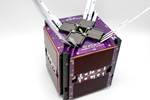CRP USA highlights 3D printing composites success for small, flight-ready satellite missions
A combination of the Windform portfolio of CFRTP and GFRTP materials and SLS printing have proven CRP’s ability to meet critical space requirements.
Tupod satellite. Source (All Images) | CRP USA
With more than a decade of experience in small satellite development, CRP USA (Mooresville, N.C., U.S.) has successfully manufactured numerous space-ready satellites for its customers using the selective laser sintering (SLS) process and Windform composite materials. These components have flown aboard several high-profile and reliable space missions.
The Windform portfolio, originally developed by CRP Technology in Italy, comprise carbon- or glass fiber-reinforced thermoplastics materials offering optimal mechanical strength, thermal resistance and dimensional stability — all critical properties for space-bound hardware.
The 3D printing composites have already been successfully employed in a variety of small satellite applications, including:
- Structural panels and enclosures
- Antenna and payload supports
- Deployable systems
- CubeSat components.
All Windform materials used in space applications have passed outgassing tests in accordance with major space agency requirements, confirming their suitability for use in orbit.
OreSat0 CubeSat.
A standout achievement is Tupod, what CRP USA contends is the first fully 3D printed CubeSat and deployer launched from the International Space Station (ISS), which enabled the historic deployment of two TubeSats into orbit.
Other examples include Windform LX 3.0 components (antenna, star tracker, battery assembly) developed for Portland State Aerospace Society’s CubeSat, OreSat0; CRP’s manufacture of the AlbaPod deployer for the SpaceX Transporter-3 mission made with Windform XT 2.0; and parts for the Discovery 1a PocketQube, also using Windform XT 2.0.
The company offers AS9100D-certified services, combining technical expertise, fast lead times and proven material performance to support innovation from prototype to launch.
Related Content
-
Combining multifunctional thermoplastic composites, additive manufacturing for next-gen airframe structures
The DOMMINIO project combines AFP with 3D printed gyroid cores, embedded SHM sensors and smart materials for induction-driven disassembly of parts at end of life.
-
Plant tour: Airbus, Illescas, Spain
Airbus’ Illescas facility, featuring highly automated composites processes for the A350 lower wing cover and one-piece Section 19 fuselage barrels, works toward production ramp-ups and next-generation aircraft.
-
Development of a composite liquid hydrogen tank for commercial aircraft
Netherlands consortium advances cryogenic composites testing, tank designs and manufacturing including AFP, hybrid winding, welding of tank components and integrated SHM and H2 sensors for demonstrators in 2025.






